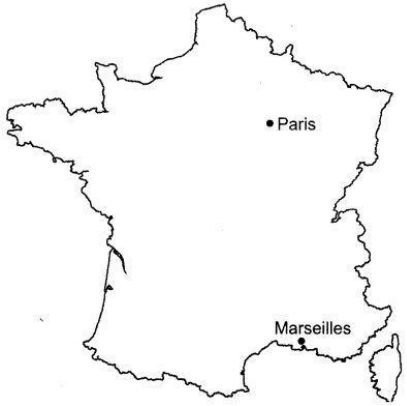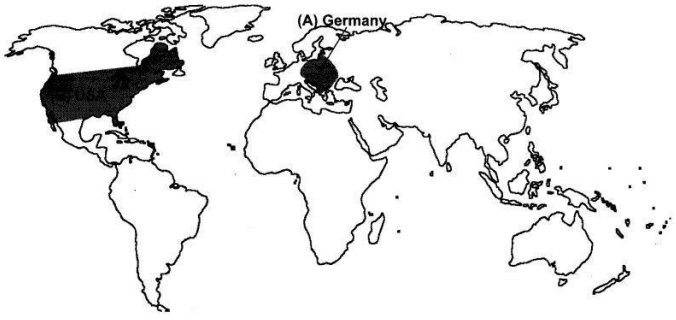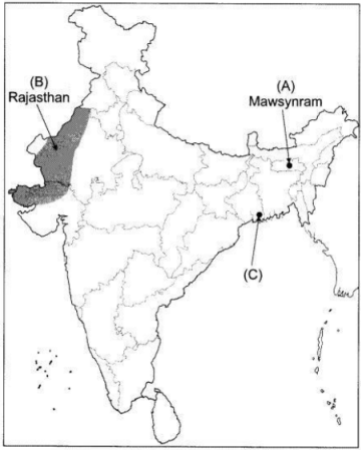Download Solved CBSE Sample Papers for Class 9 Social Science Set 2 2019 PDF to understand the pattern of questions asks in the board exam. Know about the important topics and questions to be prepared for CBSE Class 9 Social Science board exam and Score More marks. Here we have given Social Science Sample Paper for Class 9 Solved Set 2.
Board – Central Board of Secondary Education, cbse.nic.in
Subject – CBSE Class 9 Social Science
Year of Examination – 2019.
Solved CBSE Sample Papers for Class 9 Social Science Set 2
SAMPLE PAPER 2 (Solved)
Question 1:
What was a guillotine?
Answer:
It was a device comprising two poles and a blade with which a person was
beheaded during
the French Revolution.
Question 2:
When did Germany surrender to the Allies?
Answer:
Germany surrendered to the Allies in May, 1945.
Question 3:
Which type of drainage pattern does an area have where hard and soft rocks exist parallel to each other?
Answer:
Trellis drainage pattern.
Question 4:
Which land form of India is a major source of water and forest wealth?
Answer:
The Himalayan Mountains.
Question 5:
Between which latitudes does mainland of India extend?
Answer:
Between 8°4’N and 37°6’N.
Question 6:
What do we call a state where head of the state is an elected and not a hereditary person?
Answer:
Republic
Question 7:
In the village Palampur, from whom do the small farmers used to borrow money to arrange capital?
Answer:
From large farmers or moneylenders or traders.
Question 8:
Describe any three changes that took place in Germany after the passing of the famous Enabling Act of 1933.
Answer:
(i) This Act established dictatorship in Germany. It gave Hitler all powers to sideline parliament and rule by decree.
(ii) All political parties and trade unions were banned except for the Nazi party and its affiliates.
(iii) The state established complete control over the economy, media, army and judiciary.
Question 9:
Identify the conditions of workers in socialist society.
Answer:
Workers in a socialist society are looked after well. They are paid enough wages and the working conditions are improved. They have regular employment in factories and are given extra benefits. They have regular employment. They have a say in the management of industries. Peasants are given land to till. Housing and sanitation problems are well looked after. There is a socioeconomic equality in society.
Question 10:
Name the outermost range of the Himalayas. Write any two characteristics of it.
Answer:
The outermost range of the Himalayas is called the Shiwaliks. They extend over a width of 1050 km and have an altitude varying between 900 and 1100 metres. These ranges are composed of unconsolidated sediments brought down by rivers from the main Himalayan ranges located farther north. These valleys are covered with thick gravel and alluvium. The longitudinal valley lying between lesser Himalayas and the Shiwaliks are known as Duns.
Question 11:
Describe the main features of the eastern extension of the Central Highland.
Answer:
The peninsular plateau consists of two broad divisions, namely, the Central Highlands and the
Deccan plateau. The Central Highlands are wider in the west but narrower in the east. The eastward extensions of this plateau are locally known as the Bundelkhand and Baghelkhand. The Chhotanagpur plateau marks the further eastward extension, drained by the Damodar river. An extension of the plateau
is also visible in the northeast called the Meghalaya, Karbi-Anglong plateau and North Cachar Hills.
Question 12:
How were the Great Northern Plains of India formed? Explain.
Answer:
The formation of the Himalayas due to upliftment of sediments out of the Tethys Sea and subsidence of the northern flank of the Peninsular Plateau resulted in the formation of a large basin. Over millions of years this depression gradually got filled up with alluvium deposited by the three major river systems – the Indus, the Ganga and the Brahmaputra flowing from the Himalayas in the north. Sediments were also deposited by the tributaries of these rivers rising from the mountains in the north as well as the Peninsular Plateau to its south. As a result, the fertile Indo-Gangetic or Northern Plains, and the Brahmaputra Plain in the northeast, were formed.
As the Himalayas gained in height, the rivers, glaciers and other agents of denudation became increasingly active in erosion. As a result, large amount of silt got deposited in the shrinking Tethys.
Question 13:
Describe three common features of non-democratic countries.
Answer:
(i) Non-democratic countries do not offer political equality. There is limited right to vote
based on property or other qualification.
(ii) Head of the government is not directly elected by people.
(iii) There is no provision for free and fair election.
Question 14:
“Mahatma Gandhi was not a member of the Constituent Assembly, yet there were many members who followed his mission.” Explain any three values that we also must follow from the life that he led?
Answer:
Mahatma Gandhi spelt out his vision of the constitution in Young India in 1931.
(i) He insisted on social and economic equality, ‘there shall be no high class and low class of people.’
(ii) He emphasised on perfect harmony among all communities.
(iii) He was against untouchability and against intoxicating drinks and drugs.
(iv) He called for giving equal rights to women at par with men.
Question 15:
Define democracy and elaborate any two common features of it.
Answer:
Democracy is a form of government in which the rulers are elected by the people.
(i) Rulers elected by the people take all the major decisions.
(ii) Elections offer a choice and fair opportunity to the people to change their current rulers. This choice and opportunity is available to all the people on an
equal basis; and the exercise of this choice leads to a government limited by basic rules of the constitution and citizens’ rights.
Question 16:
Explain briefly three differences between market and non-market activities.
Answer:
(i) Market activities involve remumeration to any one who performs an activity for pay or profit. Non-market activities are the production for self¬consumption.
(ii) Market activities include production of goods or services including government service. Non-market activities are consumption, processing of primary product and own account production of fixed assets.
(iii) Market activities involve profit motive but non-market activities involve satisfaction.
Question 17:
Define production. Explain the role of labour in production.
Answer:
Production is to produce the goods and services that we want. There are four requirements for production of goods and services – land, labour, capital, knowledge and enterprise. Labour is an important factor of production. A producer needs people who will do the work. Some activities require skilled and semi-skilled labour whereas others require workers who can do manual work. Each worker is providing the labour necessary for production.
Question 18:
Explain the ways by which small and large farmers arrange capital for farming?
Answer:
Most small farmers have to borrow money to arrange for the capital. They borrow from large farmers or the village moneylenders or the traders who supply various inputs for cultivation. The rate of interest on such loans is very high. They are put to great distress to repay the loan. In contrast to the small farmers, the medium and large farmers have their own savings from farming. They are thus able to arrange for the capital needed. Large farmers also take up allied activities such as setting up mills, brick kilns, etc. to supplement their income. Thus, for them there is no dearth of capital.
Question 19A:
Describe scientific forestry.
Answer:
In scientific forestry, natural forests which had lots of different types of trees were cut down. In their place one type of tree was planted in straight rows. This is called a plantation. Forest officials surveyed the forests, estimated the area under different types of trees and made working plans for forest management. They planned how much of the plantation area to cut every year. The area cut was then to be replanted so that it was ready to be cut again in some years.
OR
Question 19B:
‘In Maasailand, as elsewhere in Africa, not all pastoralists were equally affected by the changes in the colonial period.’ Explain.
Answer:
In pre-colonial times, Maasai society was divided into elders and warriors. To administer the affairs of Maasai, the British appointed chiefs who were made responsible for the affairs of the people. These chiefs often accumulated wealth with which they could buy animals, goods and land. They lent money to poor neighbours who needed to pay taxes.
Many of them began living in cities and became involved in trade. Their wives and children stayed back in villages to look after animals. These chiefs managed to survive the devastation of war and drought. They had both pastoral and non-pastoral income.
But the poor pastoralists who depended only on their livestock did not have resources to tide over bad times. In times of war and famines, they lost nearly everything and had to look for work in towns.
OR
Question 19C:
Discuss: why the British Parliament passed the Enclosure Acts.
Answer:
Till the middle of the eighteenth century the Enclosure Movement proceeded very slowly. The early enclosures were usually
created by individual landlords. They were not supported by the state or the Church. After the mid-eighteenth century, however, the Enclosure Movement swept through the countryside, changing the English landscape forever. Between 1750 and 1850, 6 million acres of land was enclosed. The British Parliament no longer watched this progress from a distance. It passed 4,000 Acts legalising these Enclosures.
Question 20A:
Who are the pastoral nomads? Describe their characteristic features. Answer:
Pastoral nomads are pastoralist who keep a heard of cattles such as sheep and goats and move from one place to another in search of pasture for their cattle. Their chief features:
(i) They follow a cyclic movement in search of pastures for their cattle between summer and winter.
(ii) Their movement is mainly to adjust to seasonal changes and make the utmost use of available pastures in various places.
(iii) The pastoralists herd sheep, goats and other cattle. They consume their milk and meat and also sell them. They sell wool of sheeps.
(iv) Many pastoralists also cultivate land and engage in petty trades.
OR
Question 20B:
The spread of railways led to which new demands on forests in India after 1850s? Explain.
Answer:
The spread of railways after the 1850s led to a lot of pressure on Indian forests.
(i) Railways were required to expand due to colonial trade and movement of troops inland.
(ii) Wood was needed as fuel to run locomotives.
(iii) To lay railway tracks sleepers of wood were required in large numbers. Each mile of railway track required between 1760
to 2000 sleepers.
(iv) Thousands of trees were cut to meet the demands of railways annually. For example, In 1850, 35000 trees were cut annually in Madras Presidency alone. The government assigned the supply of sleepers to contractors who began destroying forests indiscriminately.
OR
Question 20C:
What were the effects of Enclosure Movement on the poor peasants in England?
Answer:
The poor peasants stood to lose in all aspects :
(i) They could not collect firewood from the forests or graze their cattle on the common pastures.
(ii) They could no longer collect fruits and other products from forests or hunt small animals and birds for meat.
(iii) They could no longer collect leftover and stalks from the field after the harvest. Everything belonged to the landlords and everything had to be purchased.
(iv) The poors were displaced from their land and villages. They wandered around in search of work as most of them were unemployed.
(v) The wages of labourers were reduced and they were employed only during sowing and harvesting seasons. Work became insecure, employment uncertain and income unstable. A large number of workforce had no work.
Question 21:
(a) What is the difference between climate and weather? (b) Define Ecosystem.
Answer:
(a) Climate is the term given to the weather conditions which are derived after the study of around thirty or more years. Data of these many years is compiled, analysed and then their average sum is calculated and it is termed as climate. But weather is the state of atmospheric conditions of any particular area at any particular time. It means that weather of any place can change in a day, but it will remain in the same category of climate.
(b) Every part of the world has its own climate which is quite diverse. Due to
this diversity in climatic conditions, different types of vegetation and animals are found there. Sun is the main source of energy for every living organism. Thus, every region has a typical climate with characteristic vegetation and wildlife. Together they form a system where each component is interrelated and interlinked with one another. This is called an “Ecosystem.”
Question 22:
What was the reaction of the people to the implementation of Mandal Commission Report?
Answer:
The implementation of the Mandal Commission Report led to widespread protests and counterprotests, some of which were violent. People reacted strongly because this decision affected thousands of job opportunities. Some felt that job reservations were essential to cope up with the inequalities among people of different castes in India. Others felt that this was unfair as it would deny equality of opportunity to people who did not belong to the backward communities. They would be denied jobs even if they were more qualified.
Question 23:
Explain the Right to Freedom.
Answer:
Freedom means the absence of constraints and is very necessary in democracy. So, under the Indian Constitution, all citizens have the right to :
(i) Freedom of speech and expression.
(ii) Freedom to assemble in a peaceful manner without arms.
(iv) Freedom to form associations and unions.
(v) Freedom to move freely throughout the country.
(vi) Freedom to reside in any part of the country.
(vii) Freedom to practise any profession or to carry on any occupation, trade or business.
Every citizen has the right to all these freedoms. That means a citizen cannot exercise his/her freedom in such a manner that violates others’ right to freedom. Freedom should not cause public nuisance or disorder. Freedom is not unlimited license to do what one wants.
Question 24:
When was the Rationing System introduced in India? Name the three food intervention programmes introduced in India.
Answer:
The introduction of Rationing in India dates back to the 1940s against the backdrop of the Bengal famine. The rationing system was revived in the wake of an acute food shortage during the 1960s, prior to the Green Revolution. As per report of the NSSO in the mid-1970s, three important food intervention programmes were introduced :
(i) Public Distribution System (PDS) for foodgrains to be strengthened.
(ii) Integrated Child Development Service (ICDS) introduced in 1975 on an experimental basis.
(iii) Food-for-Work [FFW] programme introduced in 1977-78.
Question 25:
‘Analysis of poverty based on social exclusion and vulnerability is now becoming very common.’ Explain.
Answer:
According to the concept of social exclusion, poverty must be seen in terms of the poor having to live only in a poor surrounding with other poor people, excluded from enjoying social equality of better-off people in better surroundings. Social exclusion can be a cause as well as a consequence of poverty in the usual sense. It is a process through which persons or groups are excluded from facilities, benefits and opportunities that others enjoy. A typical example is people belonging to certain low castes.
Vulnerability to poverty is a measure, which describes the greater probability of certain communities (say, backward castes, widows, disabled persons) of becoming or remaining poor in future. Vulnerability is determined by the options available to different communities for finding an alternative living in terms of assets, education, health and job opportunities. Further, it is analysed on the basis of the greater risks these groups face during natural calamities, terrorism, etc.
Question 26:
Locate and label the following on the given outline map of France.
(i) Paris (ii) Marseilles
Answer:

Question 27:
Two items A and B are marked on the given outline map of world. Identify
these with the help of the given information and write their correct names.
(A) A major Central Power during the First World War.
(B) A major Allied Power during Second World War.
Answer:

Question 28:
Two items A and B are shown on given outline political map of India. Identify these items with the help of following information and write their correct names.
(A) Place receiving maximum annual rainfall.
(B) Area receiving rainfall less than 40 cm but more than 20 cm.
On the same map of India, locate and label the following item with appropriate symbol:
(C) Sunderbans

Note : The following questions are for the Blind Candidates only, in lieu of Q. No. 26, 27 and 28.
(28.1) Name a major Central Power during the First World War.
(28.2) Name a major Allied Power during the Second World War.
(28.3) Name an area of Mangrove forest in West Bengal.
(28.4) Name a bird sanctuary in Rajasthan.
(28.5) Name the place with the highest amount of rainfall.
Answer:
(28.1) Germany
(28.2) USA
(28.3) Sunderbans
(28.4) Bharatpur Bird Sanctuary
(28.5) Mawsynram
We hope the Solved CBSE Sample Papers for Class 9 Social Science Set 2, help you. If you have any query regarding CBSE Sample Papers for Class 9 Social Science Solved Set 2, drop a comment below and we will get back to you at the earliest.